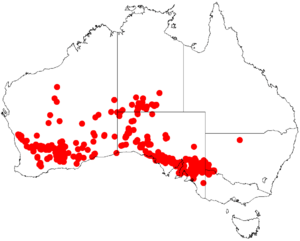Pin bush facts for kids
Quick facts for kids Pin bush |
|
|---|---|
| Scientific classification | |
| Genus: |
Acacia
|
| Species: |
nyssophylla
|
 |
|
| Occurrence data from AVH | |
The Acacia nyssophylla, also known as pin bush, wait a while, or spine bush, is a type of shrub. It belongs to the Acacia family, which is a large group of plants. This particular bush is found only in certain parts of central, south-western, and southern Australia. It's known for its spiky appearance.
Contents
What the Pin Bush Looks Like
This interesting shrub usually grows to be about 0.5 to 3 metres (2 to 10 ft) tall. It has many branches that can look a bit tangled and are prickly. The branches are smooth and have marks where its leaf-like parts used to be.
Like most Acacia plants, the pin bush doesn't have true leaves. Instead, it has special flat stems called phyllodes. These phyllodes are always green and are attached to yellow parts of the stem. They are stiff, dull, and smooth. Each phyllode is about 15 to 35 mm (0.59 to 1.38 in) long and about 1.5 mm (0.059 in) wide. They have many faint lines or veins.
The pin bush blooms from July to October, sometimes even into November. Its flowers grow in small, round or oval clusters. These clusters are about 3.5 to 6 mm (0.14 to 0.24 in) wide and usually appear in pairs where the phyllodes meet the stem. Each cluster has 12 to 19 golden-colored flowers.
After the flowers, seed pods start to grow. These pods are firm and shaped like a line. They are a bit squeezed between each seed and can be curved or even coiled once. The smooth pods are about 3 to 6.5 cm (1.2 to 2.6 in) long and 2 to 5 mm (0.079 to 0.197 in) wide. They have veins running along their length. Inside, the seeds are shiny black and shaped like a spear or an oval. They are about 4 to 5 mm (0.16 to 0.20 in) long and have a large orange or yellow cap called an aril.
How the Pin Bush Got Its Name
The pin bush was first officially described in 1863 by a scientist named Ferdinand von Mueller. He studied a plant sample collected by Benjamin Herschel Babbage near Lake Gairdner in South Australia.
The second part of its scientific name, nyssophylla, comes from two Greek words. Nysso means "to pierce," and phyllon means "leaf." This name was chosen because the phyllodes (the leaf-like parts) of the pin bush are stiff and pointy, almost like they could pierce something!
Where the Pin Bush Grows
The pin bush is found in many different parts of Australia. It grows in the Wheatbelt and Goldfields-Esperance areas of Western Australia. You can also find it across South Australia and even in the very north-western part of Victoria. Further north, it grows near Alice Springs in the Northern Territory, and in western New South Wales near Bourke.
Images for kids



